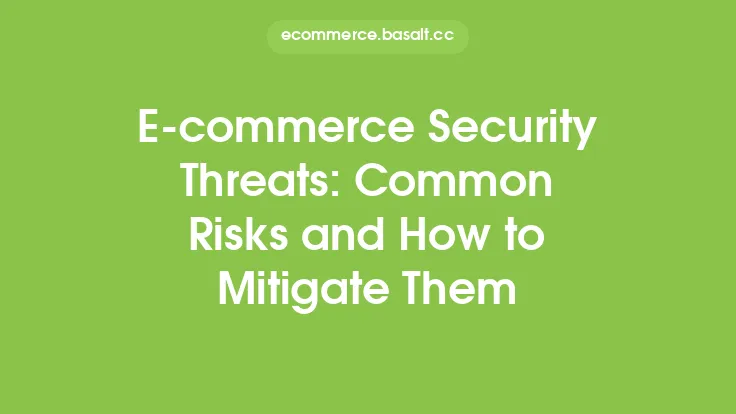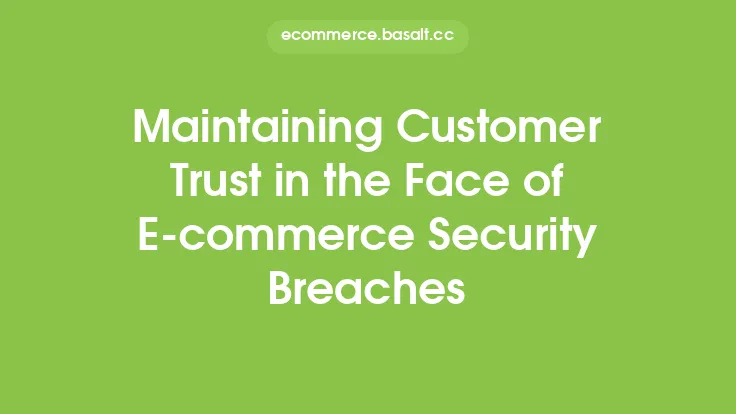As the e-commerce industry continues to grow, online stores are becoming increasingly vulnerable to security threats. These threats can compromise sensitive customer data, disrupt business operations, and damage a company's reputation. It is essential for e-commerce businesses to be aware of the common security threats they face and take proactive measures to mitigate them.
Types of E-commerce Security Threats
E-commerce security threats can be broadly categorized into several types, including malware and viruses, phishing attacks, SQL injection attacks, cross-site scripting (XSS) attacks, and distributed denial-of-service (DDoS) attacks. Malware and viruses are malicious software programs that can infect a website and steal sensitive data or disrupt business operations. Phishing attacks involve tricking customers into revealing sensitive information, such as passwords or credit card numbers, through fake emails or websites. SQL injection attacks involve injecting malicious code into a website's database to extract or modify sensitive data. XSS attacks involve injecting malicious code into a website to steal sensitive data or take control of user sessions. DDoS attacks involve overwhelming a website with traffic to make it unavailable to customers.
Mitigating E-commerce Security Threats
To mitigate e-commerce security threats, businesses can take several measures. First, they should ensure that their website and payment gateway are compliant with industry security standards, such as the Payment Card Industry Data Security Standard (PCI DSS). They should also implement robust security protocols, such as encryption and secure sockets layer (SSL) certificates, to protect sensitive customer data. Additionally, they should regularly update their website and payment gateway with the latest security patches and software updates. They should also use web application firewalls (WAFs) to detect and prevent common web attacks, such as SQL injection and XSS attacks.
Best Practices for E-commerce Security
To ensure the security of their online store, e-commerce businesses should follow best practices, such as validating user input, using secure protocols for data transmission, and implementing access controls to restrict access to sensitive data. They should also regularly monitor their website and payment gateway for security vulnerabilities and take prompt action to address any issues that are detected. They should also have an incident response plan in place to quickly respond to security incidents, such as data breaches or DDoS attacks. Furthermore, they should provide security awareness training to their employees to educate them on e-commerce security best practices and the importance of protecting sensitive customer data.
The Importance of Regular Security Audits
Regular security audits are essential for identifying and addressing security vulnerabilities in e-commerce websites and payment gateways. These audits involve scanning a website and payment gateway for security vulnerabilities, such as outdated software or insecure protocols, and providing recommendations for remediation. They can help e-commerce businesses identify potential security threats before they are exploited by hackers, reducing the risk of data breaches and other security incidents. Regular security audits can also help e-commerce businesses ensure compliance with industry security standards, such as PCI DSS, and reduce the risk of fines and penalties for non-compliance.
The Role of E-commerce Platforms in Security
E-commerce platforms, such as Shopify and Magento, play a critical role in e-commerce security. These platforms provide a range of security features, such as encryption and secure protocols, to protect sensitive customer data. They also provide regular security updates and patches to address security vulnerabilities and ensure compliance with industry security standards. E-commerce businesses should choose a platform that prioritizes security and provides robust security features to protect their online store and customers. They should also ensure that their platform is configured correctly and that all security features are enabled to maximize security.
Conclusion
E-commerce security threats are a growing concern for online businesses, and it is essential for them to be aware of the common threats they face and take proactive measures to mitigate them. By implementing robust security protocols, following best practices, and conducting regular security audits, e-commerce businesses can reduce the risk of security incidents, such as data breaches and DDoS attacks, and protect sensitive customer data. Additionally, choosing a secure e-commerce platform and providing security awareness training to employees can also help ensure the security of an online store. By prioritizing e-commerce security, businesses can build trust with their customers, protect their reputation, and ensure the long-term success of their online store.





